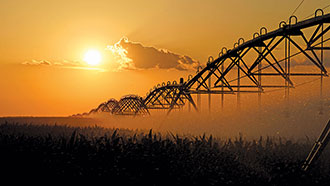
Center pivot irrigation systems are among the most popular and efficient modern agricultural irrigation methods. This article explores the basics of center pivot irrigation, including how it works, its benefits, and its potential drawbacks. Here, you will find a comprehensive introduction to center pivot irrigation, whether you are a farmer looking to optimize your irrigation practices or simply curious about this innovative technology.
What is Center Pivot Irrigation?
Center-pivot irrigation is a crop irrigation method involving an extensive steel structure employing attached individual sprinklers. The system's mainline rotates around a central point called "pivot point." The sprinklers are positioned in outlets spaced along the length of the mainline, and as it rotates, water is evenly distributed over the crops. This irrigation method is efficient and highly effective in ensuring crops receive the proper moisture. It's commonly used to cover a vast expanse of land.
How Does a Center Pivot Irrigation System Work?
The center pivot irrigation system operates on a simple yet effective mechanism—the pivot is essentially a long water pipe that is supported by mobile towers. Water is supplied from the center and flows outward through the pipe.
A motor powers the system's movement, allowing it to rotate 360 degrees or smaller portions depending on the field shape. As the pivot rotates, the attached sprinklers distribute water across the field. This mechanical move system can distribute water evenly, reducing the risk of overwatering or underwatering the crops.
Origins and Evolutions: The Contribution of Farmer Frank Zybach
Frank Zybach, an innovative farmer, is credited for developing the prototype for the first mechanized, self-propelled sprinkler system that would rotate around a central pivot. This 1940s concept optimized irrigation water use, replacing older practices like surface irrigation. This was especially crucial in areas like the Great Plains, where vital water sources like the Ogallala aquifer needed sustainable management.
Center Pivot Technology: A Marvel in Modern Irrigation
 In the decades since Zybach's invention, center pivots have seen numerous advancements. Components like pressure regulators have become crucial in modern center pivot system designs, providing water delivery at consistent pressures across the entire pivot length despite variations in elevation and distance from the pivot point.
In the decades since Zybach's invention, center pivots have seen numerous advancements. Components like pressure regulators have become crucial in modern center pivot system designs, providing water delivery at consistent pressures across the entire pivot length despite variations in elevation and distance from the pivot point.
With many technological advancements, including GPS (Global Positioning System), VRI (Variable Rate Irrigation), AI (Artificial Intelligence), IoT (Internet of Things) enabled sensors, and wireless controllers, modern center pivot systems can be managed and monitored remotely, ensuring precise water application, and aiding in conserving resources.
Benefits of Center Pivot Irrigation
- Efficiency: Center pivot systems are renowned for their water efficiency. Compared to traditional flood irrigation, less water is lost to evaporation and runoff.
- Versatility: Modern systems can be adapted to use varied water application rates based on soil moisture sensors, ensuring each crop section gets what it needs.
- Labor-saving: Center pivots require minimal labor once installed and set up. They can also be equipped with technology for remote monitoring and customized control.
- Uniform Water Distribution: Ensures even water distribution, which promotes consistent crop growth across fields.
Advantages & Disadvantages
Advantages:
- Reduced Soil Erosion: Unlike flood irrigation, center pivot systems distribute water gently, reducing the chances of soil erosion.
- Fertilizer and Chemical Application: Some systems allow growers to incorporate fertilizer and chemical application, ensuring uniform distribution.
- Adaptable to Terrain: Although best suited for flat terrains, center pivot systems can be designed to accommodate slopes within the field.
Disadvantages:
- Initial Cost: Installing a center pivot irrigation system can be expensive, especially for larger fields.
- Energy Costs: The system relies on continuous power to drive the motor and pump, which can be costly.
- Circular Irrigation Pattern: The circular pattern leaves corners of square or rectangular fields unirrigated. However, additions like corner arm systems and end-of-pivot guns or sprinklers can help mitigate this.
How Long Do Center Pivot Irrigation Systems Last?
With proper maintenance, pivot systems can last 15 to 25 years. Longevity depends on factors like water quality, system usage, and the quality of materials used by the center pivot manufacturer.
Understanding Center Pivot Irrigation Costs
- Installation Costs: The initial investment includes the system components and installation costs. Field size and system complexity can affect prices.
- Operational Costs: This includes energy for the motor and pump and periodic system maintenance costs.
- Replacement Costs: Parts like sprinklers, pressure regulators, seals, and tires might need replacement throughout the system's life.
For a detailed breakdown of the center pivot irrigation system cost, it's best to consult the pivot manufacturer or local distributor.
Leading Center Pivot Irrigation Manufacturers
Several companies have made a mark in the industry with their innovative products. Some top center pivot irrigation manufacturers based in the USA who distribute worldwide are Valmont Industries (Valley machines), Lindsay Corporation (Zimmatic machines), Reinke Manufacturing Company, and T-L Irrigation Company. Many other manufacturers worldwide exist, including AFKO, Bauer, Fockink, Irrifrance, Ocmis Irrigazione, Otech, RKD, and Variant.
Conclusion
Center pivot irrigation systems, a significant advancement in agriculture, offer growers a balance of efficiency, reduced labor costs, and adaptability. By understanding their mechanics, benefits, and costs, growers can select the solutions that best suit their unique needs. For more information or to explore options tailored to specific needs, contacting local experts or manufacturers is always recommended.

